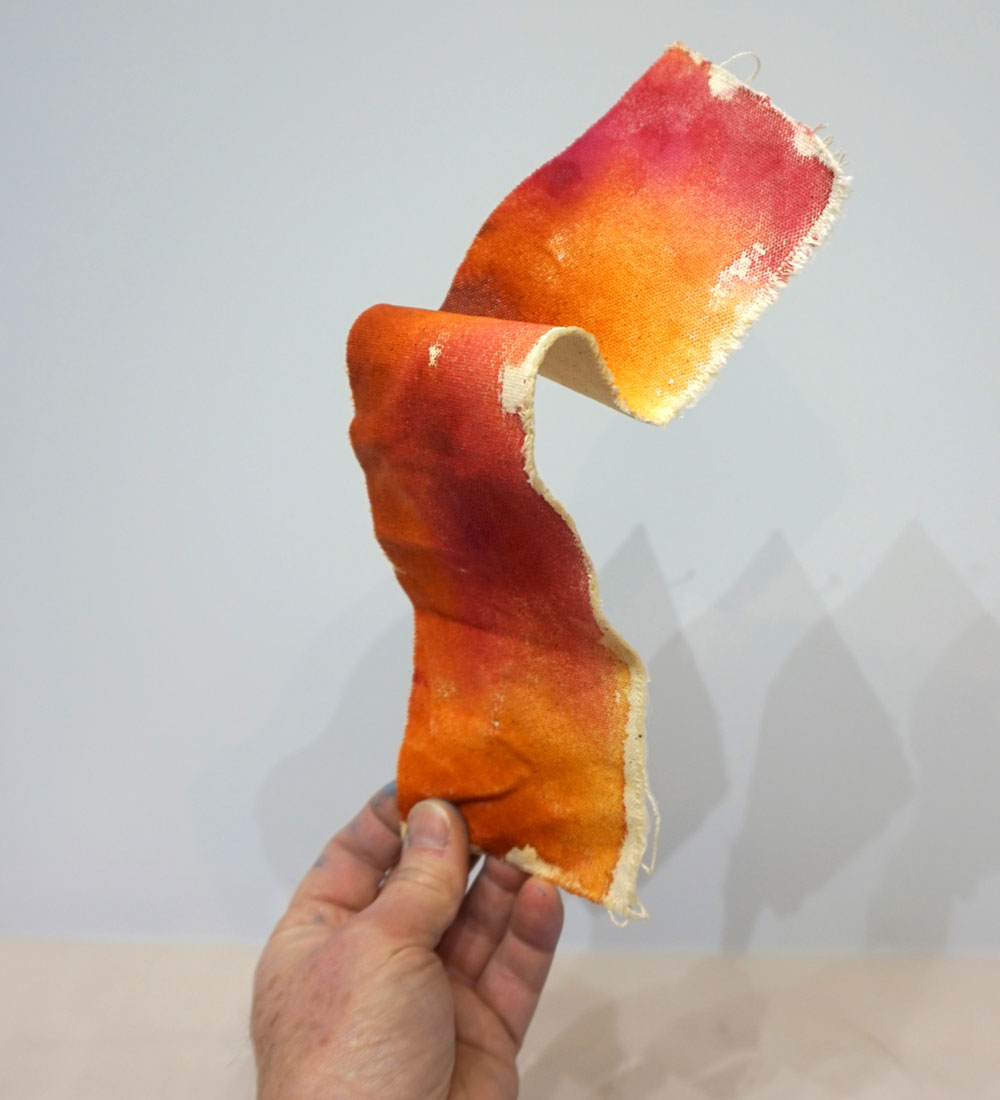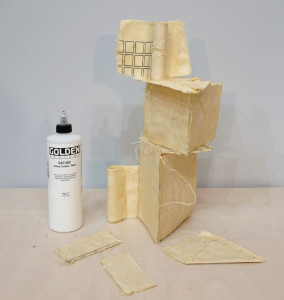GAC 400 is used to stiffen fabric or paper made from natural fibers. It is a water-borne acrylic that dries to a hard, stiff film. One good coat that soaks in well should be enough to stiffen the material. It can be used to replace rabbit skin glue for stiffening linen and canvas in preparation for oil painting. If you would like to build larger scaled, free-standing structures, it will need the help of an internal or external rigid structure.
GAC 400 should soak into the fibers of the fabric or paper so it is functioning throughout the material. It should not be applied thickly and will function best if not diluted. Depending on your specific application, you may opt to heat-set GAC 400 to decrease water sensitivity, and increase the stiffening properties to some degree.
Care should be taken not to roll, stretch or bend any fabric or paper stiffened with GAC 400 as micro cracks will form that will eventually decrease the stiffness of the material. One ounce of GAC 400 should cover about 1 square foot. The soaking method will use more product.
Two Most Common Uses for GAC 400
1. Fabric, Textile and Paper Stiffening Applications
Brush apply GAC 400 to the paper or fabric liberally, allowing it to soak into the material. Thicker natural fabrics like cotton canvas work best. Excess product sitting unevenly is fine, as it will become translucent and much less visible when dry. Expect some gloss on the surface and a slight darkening of the fabric. For even more stiffness, you can soak the fabric or paper in GAC 400 that has been poured into a shallow container. Wipe off the excess and drape or position for drying. Again, you do not need to be so concerned about removing all the excess medium. Latex or vinyl gloves are recommended for this technique.


Polyethylene plastic sheeting works well as a non-stick surface for the wet fabric pieces and you should be able to peel the fabric off when dry, but paper may be more of a challenge as it can tear easily if stuck to the plastic. Some heavier weight papers may work better. It is always best to use acid free paper for any fine art application.
For sculptural uses, GAC 400 is best used on small scale paper or fabric pieces, as it may be difficult for heavy or very large objects to retain their shape. It can be helpful to drape the wet material over a form to keep its shape as it dries, but the form should be made of HDPE plastic or covered with polyethylene plastic sheeting to prevent sticking. Smaller pieces of fabric can be stiffened and assembled by gluing the pieces together in an architectural fashion, using thicker Gel Mediums like our High Solid Gels. Think post and lintel construction. This method works quite well as you can see in the photo. It will still be a somewhat delicate structure and should be handled carefully.


Various types of bas relief paper collage can be done using GAC 400 soaked paper adhered to an appropriate substrate and manipulated to create raised and textured surfaces. Rigid panels are best. The paper or fabric can be painted once dry.
2. Rabbit Skin Glue Replacement
Materials like Rabbit Skin Glue are extremely hygroscopic, which means literally ‘water loving’, and will respond rapidly to changes in relative humidity, dramatically tightening and growing slack in the process. As a safer alternative, GAC 400 can be used as a size on canvas or linen, stiffening them in a similar way as rabbit skin glue, but without the same amount of sensitivity to humidity. This allows it to retain its stiffness over a much wider range of ambient conditions, although it remains vulnerable to prolonged contact with water. To lessen that sensitivity, please see the following section on Heat Setting.
Please note, unlike Rabbit Skin Glue, GAC 400 will not block oil penetration so additional steps are needed before painting with oils.
This link to a directory of our fluid acrylic mediums including the special purpose polymers, and another specifically for GAC 400.
Heat-Setting Option and Recommendations:
While GAC 400 is rarely heat-set, and will work to stiffen materials without it, heat-setting does provide some benefits such as much less water sensitivity and some increase in stiffness. If heat-setting is not done, pieces with GAC 400 should not have prolonged contact with water, nor ever be immersed, as the medium could soften or possibly liquefy.
To heat-set, allow GAC 400 to dry overnight. Using a hair dryer set on high, heat-set GAC 400 for 5 or 10 minutes. This heat-setting is based on temperature and duration; the hotter the setting, the faster the process will be. Do not scorch the surface. The temperatures in hair driers can vary greatly so it is best to select one which seems to offer the hottest settings.
Please note that heat-setting GAC 400 releases trace amounts of formaldehyde, which may be of concern to those with chemical sensitivities. We recommend providing fresh-air ventilation when using heat-set products.
